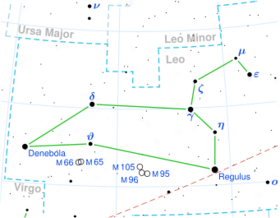Astronomy:Iota Leonis
| Observation data Equinox J2000.0]] (ICRS) | |
|---|---|
| Constellation | Leo |
| Right ascension | 11h 23m 55.45273s[1] |
| Declination | +10° 31′ 46.2195″[1] |
| Apparent magnitude (V) | 4.00[2] |
| Characteristics | |
| Spectral type | F4 IV[3] |
| U−B color index | +1.420[4] |
| B−V color index | +0.456[4] |
| Variable type | Suspected[5] |
| Astrometry | |
| Radial velocity (Rv) | −10.3[6] km/s |
| Proper motion (μ) | RA: +141.45[1] mas/yr Dec.: −79.14[1] mas/yr |
| Parallax (π) | 41.26 ± 1.16[1] mas |
| Distance | 79 ± 2 ly (24.2 ± 0.7 pc) |
| Absolute magnitude (MV) | +2.13[7] |
| Orbit[8] | |
| Primary | ι Leo A |
| Companion | ι Leo B |
| Period (P) | 186 yr |
| Semi-major axis (a) | 1.91″ |
| Eccentricity (e) | 0.53 |
| Inclination (i) | 128° |
| Longitude of the node (Ω) | 235° |
| Periastron epoch (T) | B 1948.8 |
| Argument of periastron (ω) (secondary) | 325° |
| Details | |
| Mass | 1.62−1.70[3] M☉ |
| Radius | 2.1[9] R☉ |
| Luminosity | 11.5[3] L☉ |
| Surface gravity (log g) | 3.98[10] cgs |
| Temperature | 6,739[10] K |
| Metallicity [Fe/H] | 0.06[10] dex |
| Rotational velocity (v sin i) | 16[3] km/s |
| Age | 1.7[3] Gyr |
| Other designations | |
| Database references | |
| SIMBAD | data |
Iota Leonis, Latinized from ι Leonis, is a triple star system in the constellation Leo. The system is fairly close to the Sun, at only 79 light-years (24.2 parsecs) away, based on its parallax.[1] The system has a combined apparent magnitude of 4.00[2] making it faintly visible to the naked eye. It is moving closer to the Sun with a radial velocity of −10 km/s.[6]
Iota Leonis has a spectral type of F3 IV,[3] matching that of an F-type subgiant star. It is a spectroscopic binary, which means it is a binary star with components that are too close together to be able to resolve individually through a telescope. In this case, light from only the primary star can be detected, and it is considered single-lined.[3]
The third component in the star system is designated Iota Leonis B. It orbits the central pair almost every 200 years, and with its perihelion passage in 1948, the separation between the two is steadily growing.[12] Iota Leonis B has a mass approximately 8% greater than that of the Sun.[12] It is a G-type main-sequence star, like the Sun.[13]
Name
In Chinese, 太微右垣 (Tài Wēi Yòu Yuán), meaning Right Wall of Supreme Palace Enclosure, refers to an asterism consisting of ι Leonis, β Virginis, σ Leonis, θ Leonis and δ Leonis.[14] Consequently, the Chinese name for ι Leonis itself is 太微右垣三 (Tài Wēi Zuǒ Yuán sān, English: the Third Star of Right Wall of Supreme Palace Enclosure.),[15] representing 西次將 (Xīcìjiāng), meaning The Second Western General.[16] 西次將 (Xīcìjiāng), spelled Tsze Tseang by R.H. Allen, means "the Second General" [17]
See also
References
- ↑ 1.0 1.1 1.2 1.3 1.4 1.5 van Leeuwen, Floor (November 2007), "Validation of the new Hipparcos reduction", Astronomy and Astrophysics 474 (2): 653–664, doi:10.1051/0004-6361:20078357, Bibcode: 2007A&A...474..653V Note: see VizieR catalogue I/311.
- ↑ 2.0 2.1 2.2 "iot Leo -- Spectroscopic binary". SIMBAD. Centre de Données astronomiques de Strasbourg. http://simbad.u-strasbg.fr/simbad/sim-basic?Ident=iot+Leo.
- ↑ 3.0 3.1 3.2 3.3 3.4 3.5 3.6 Bi, S.-L.; Basu, Sarbani; Li, L.-H. (February 2008). "Seismological Analysis of the Stars γ Serpentis and ι Leonis: Stellar Parameters and Evolution". The Astrophysical Journal 673 (2): 1093–1105. doi:10.1086/521575. Bibcode: 2008ApJ...673.1093B.
- ↑ 4.0 4.1 Rufener, F. (October 1976). "Second catalogue of stars measured in the Geneva Observatory photometric system". Astronomy & Astrophysics Supplement Series 26: 275–351. Bibcode: 1976A&AS...26..275R.
- ↑ Kukarkin, B. V. (1981). "Nachrichtenblatt der Vereinigung der Sternfreunde e.V. (Catalogue of suspected variable stars)". Nachrichtenblatt der Vereinigung der Sternfreunde (Moscow, Academy of Sciences USSR Shternberg). Bibcode: 1981NVS...C......0K.
- ↑ 6.0 6.1 Wilson, R. E. (1953). "General Catalogue of Stellar Radial Velocities". Washington D.C.: Carnegie Institute. Bibcode: 1953GCRV..C......0W.
- ↑ Anderson, E.; Francis, Ch. (2012), "XHIP: An extended hipparcos compilation", Astronomy Letters 38 (5): 331, doi:10.1134/S1063773712050015, Bibcode: 2012AstL...38..331A.
- ↑ "Sixth Catalog of Orbits of Visual Binary Stars". United States Naval Observatory. http://www.usno.navy.mil/USNO/astrometry/optical-IR-prod/wds/orb6.
- ↑ Malagnini, M. L.; Morossi, C. (November 1990), "Accurate absolute luminosities, effective temperatures, radii, masses and surface gravities for a selected sample of field stars", Astronomy and Astrophysics Supplement Series 85 (3): 1015–1019, Bibcode: 1990A&AS...85.1015M
- ↑ 10.0 10.1 10.2 Balachandran, Suchitra (May 1, 1990). "Lithium depletion and rotation in main-sequence stars". Astrophysical Journal, Part 1 354: 310–332. doi:10.1086/168691. Bibcode: 1990ApJ...354..310B.
- ↑ Golovin, Alex; Reffert, Sabine; Just, Andreas; Jordan, Stefan; Vani, Akash; Jahreiß, Hartmut (November 2022). "The Fifth Catalogue of Nearby Stars (CNS5)". Astronomy & Astrophysics 670: A19. doi:10.1051/0004-6361/202244250. Bibcode: 2023A&A...670A..19G. Catalogue can be accessed here.
- ↑ 12.0 12.1 Fuhrmann, Klaus (2008). "Nearby stars of the Galactic disc and halo - IV". Monthly Notices of the Royal Astronomical Society 384 (1): 173–224. doi:10.1111/j.1365-2966.2007.12671.x. Bibcode: 2008MNRAS.384..173F.
- ↑ "BD+11 2348B". SIMBAD. Centre de données astronomiques de Strasbourg. http://simbad.u-strasbg.fr/simbad/sim-basic?Ident=BD%2B11+2348B.
- ↑ (in Chinese) 中國星座神話, written by 陳久金. Published by 台灣書房出版有限公司, 2005, ISBN:978-986-7332-25-7.
- ↑ (in Chinese) 香港太空館 - 研究資源 - 亮星中英對照表 , Hong Kong Space Museum. Accessed on line November 23, 2010.
- ↑ (in Chinese) English-Chinese Glossary of Chinese Star Regions, Asterisms and Star Name , Hong Kong Space Museum. Accessed on line November 23, 2010.
- ↑ Richard Hinckley Allen (1963). "LacusCurtius • Allen's Star Names — Leo". Star Names. https://penelope.uchicago.edu/Thayer/E/Gazetteer/Topics/astronomy/_Texts/secondary/ALLSTA/Leo*.html.
 |


